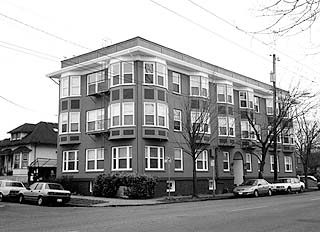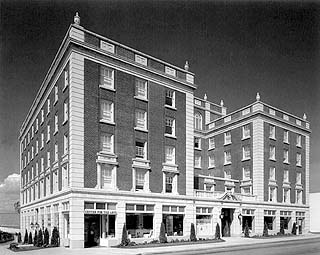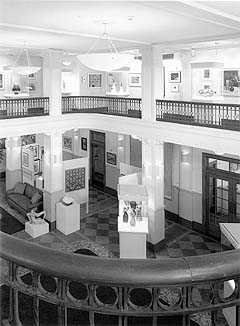
DJC.COM
August 9, 2001
Getting the ball rolling with affordable housing
Washington Community Reinvestment Association

Reed |
Communities throughout the Puget Sound region are benefiting daily from the resources and expertise of the affordable housing industry. Though it may surprise some, the creation and rehabilitation of affordable housing has proven to be a dynamic component in successful urban development and renewal.
Often, by targeting a pivotal building in an area, affordable housing developers can be the catalyst to “get the ball rolling” toward a greater effort. Providing housing to serve a wide array of income levels creates the strong residential base needed to support small business and commercial expansion.
Getting capital

Photos courtesy of WCRA The historic Harvey Apartments in Seattle’s Central District were renovated into 20 units of affordable housing, thanks to the Central Area Development Association.
|

With its ground-floor commercial and affordable housing above, the rehabilitated Columbia Hotel brings a new vitality to the Columbia City neighborhood. |

After standing vacant for 20 years, Everett’s Monte Cristo Hotel now houses 69 units of affordable housing. |
One of the biggest challenges affordable housing developers face is securing permanent funding for their projects. To meet this need, a group of Washington banks created a non-profit banking consortium called the Washington Community Reinvestment Association. WCRA specializes in affordable housing and provides the private capital needed to leverage and expand public funding resources.
Since beginning in 1992, WCRA has grown to include 37 member banks and has committed over $130 million to support the creation and rehabilitation of nearly 5,500 units of housing in urban and rural communities across Washington.
Preserving history
The Central District of Seattle is alive with redevelopment energy, much of it stimulated by the Central Area Development Association (CADA), a non-profit community development corporation. One of the goals in its efforts to expand residential opportunities is to do so without losing the unique architectural heritage of the area. When it acquired the historic Harvey Apartments on Cherry Street, CADA took a step toward that goal.
Built in 1909 as an office building, the Harvey had been converted to apartments that were in need of serious attention. To complete the Harvey’s renovation, CADA assembled a package of financing sources which included a loan from WCRA. The Harvey Apartments now provide 20 units of affordable housing that retain their historic character and create an opportunity for people to live and shop in the Central District.
Living above the store
Seattle’s Columbia City neighborhood provides another example of the positive impact affordable housing can have on the economic development of an area. Drawing on a broad array of public and private funding sources, including a loan from WCRA, Southeast Effective Development (SEED) acquired and renovated a historic building that has been part of Columbia City since 1892.
Like many older buildings in Seattle, the Columbia Hotel had suffered from deferred maintenance and neglect. SEED however, looked past that neglect and recognized an opportunity to rehabilitate not only a building but lend new vitality to a neighborhood.

During renovation of the Monte Cristo in Everett, the hotel’s original stained glass ceiling was uncovered. |
It borrowed a concept from the time when the Columbia Hotel was first built and showed that “living above the store” could be a viable option in today’s world. Now eight units of affordable housing crown the street-level commercial activity where neighbors can gather to share coffee and conversation.
Culture and housing
The city of Everett has been engaged in a downtown revitalization effort for several years. Today, the downtown streets are bustling with activity. Restaurants and shops line Colby Street and plans are underway to redesign the waterfront and open up access to the community.
In 1992 the picture looked less bright. The Monte Cristo Hotel, a historic 1920’s building, stood in the middle of the central business district. For over 20 years this once magnificent building had stood empty, its only purpose to provide a growing population of pigeons with decaying shelter. Although many attempts were made to reclaim the Monte Cristo, none has been successful. The Monte Cristo was not only an eyesore; it was a visible barrier to a downtown renaissance.
| Washington Community Reinvestment Association members: |
|
Anchor Savings Bank; Bank of America; Bank of the West; Banner Bank; Cascade Bank; Cashmere Valley Bank; Charter Bank; City Bank; Columbia Bank; The Commerce Bank of Washington; Evergreen Bank; Evertrust Bank; First Federal Savings & Loan Association of Port Angeles; First Mutual Bank; Frontier Bank; Heritage Bank; Homestreet Bank; Horizon Bank; Key Bank; Northern Trust Bank; Olympia Federal Savings & Loan Association; Pacific Northwest Bank; Redmond National Bank; Riverview Community Bank; Skagit State Bank; Sterling Savings Association; Timberland Bank; Union Bank of California; U.S. Bank of Washington; Washington Federal Savings; Washington First International Bank; Washington Mutual Bank; Washington Trust Bank; Wells Fargo Bank; West Coast Bank; Whidbey Island Bank; Yakima Federal S&L Association.
|
When Lojis Corp. became interested in the Monte Cristo, it approached the city with a new idea. Recognizing the need for affordable housing in the downtown core, Lojis determined there was a way to meet that need and bring new life to the Monte Cristo. With the support of local government, federal low-income housing and historic tax credit programs were used to create an opportunity for major corporate investment. With the investment resources in place and a loan from WCRA, the restoration project began.
Today, 69 units of affordable housing showcase the new Monte Cristo, with households occupying the upper floors. The street level is home to the city’s Cultural Commission. In addition to its offices, space is provided for a public art museum, shows and exhibitions. During the restoration process, an unexpected bonus was discovering the original hotel ballroom’s domed, stained glass ceiling.
These projects offer a small glimpse of the numerous ways in which affordable housing can support historic renovation and provide economic stimulation to a neighborhood. Investing in affordable housing not only creates a home for an individual family, it generates a positive economic impact felt throughout the community. To the financial institutions that participate in the Washington Community Reinvestment Association, providing capital to support housing for all income levels is a strategy that results in good community development and good business.
Judy Reed is president of the Washington Community Reinvestment Association, a non-profit consortium of financial institutions providing permanent financing for community development projects across Washington.
Other Stories:
- The future is looking UP
- Urban form gets its roots from nature
- Downtown becomes a shopping mecca
- Earth-shaking discoveries impact design
- The scoop on infill development
- Infill problems? Get creative
- Rubbernecking leads urban retail revival
- Rx for Seattle’s growing pains: Collaboration
- DSA puts a downtown neighborhood on the ‘Edge’
- Public places — look between the buildings
- A blast from the past — modernism is back
- Energizing Everett
- Urban development versus the public process
- Protecting views makes sense from every angle
- Urban development picture includes artists
- Pricing gridlock out of the market
- Retail? Start with the first floor
Copyright ©2009 Seattle Daily Journal and DJC.COM.
Comments? Questions? Contact us.